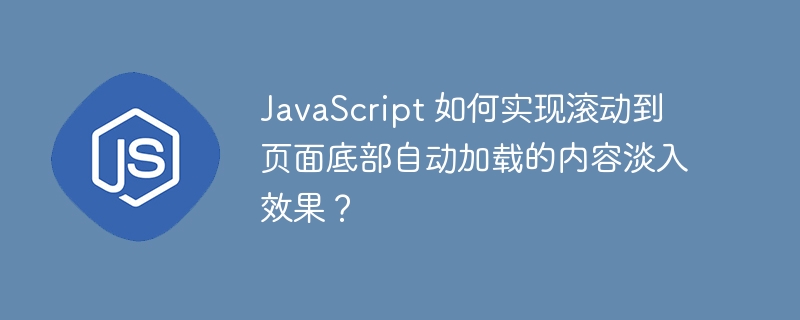

JavaScript How to achieve the fade-in effect of automatically loading content after scrolling to the bottom of the page?
In modern web design, it is a very common requirement to scroll to the bottom of the page to automatically load content with a fade-in effect. This article will use JavaScript as an example to introduce how to achieve this effect.
First, we need to use JavaScript to listen for page scroll events. When scrolling to the bottom of the page, we will trigger a function that loads new content.
// 监听页面滚动事件
window.addEventListener('scroll', function() {
// 获取文档内容的高度
var documentHeight = document.documentElement.scrollHeight;
// 获取视口的高度
var windowHeight = window.innerHeight;
// 获取滚动条的位置
var scrollTop = window.pageYOffset || document.documentElement.scrollTop || document.body.scrollTop;
// 判断是否滚动到页面底部
if (scrollTop + windowHeight >= documentHeight) {
// 加载新内容的函数
loadContent();
}
});After listening to the scroll to the bottom of the page, we can write a loadContent function to load new content. Here we assume that the new content is obtained through an Ajax request. Before loading new content, you can use CSS to make the new content invisible so that it can fade in later.
function loadContent() {
// 创建XMLHttpRequest对象
var xhr = new XMLHttpRequest();
// 设置请求方式和URL
xhr.open('GET', 'http://example.com/load-more-content', true);
// 监听请求状态变化事件
xhr.onreadystatechange = function() {
if (xhr.readyState === XMLHttpRequest.DONE && xhr.status === 200) {
// 请求成功,将新内容插入到页面中
var newContent = xhr.responseText;
var container = document.getElementById('content-container');
container.innerHTML += newContent;
// 将新内容设置为不可见
var newElements = container.querySelectorAll('.new');
for (var i = 0; i < newElements.length; i++) {
newElements[i].style.opacity = 0;
}
// 淡入效果
fadeIn(newElements);
}
};
// 发送请求
xhr.send();
}Finally, we need to write a fadeIn function to achieve the fade-in effect. You can use the CSS transition attribute with JavaScript to achieve a fade-in transition effect.
function fadeIn(elements) {
// 获取元素的个数
var count = elements.length;
// 定义计数器
var index = 0;
function animate() {
// 将元素的透明度逐渐增加
elements[index].style.opacity = parseFloat(elements[index].style.opacity) + 0.05;
// 判断是否所有元素都已经淡入完毕
if (parseFloat(elements[index].style.opacity) >= 1) {
// 如果还有未淡入的元素,则继续执行淡入动画
if (index < count - 1) {
index++;
animate();
}
} else {
// 利用requestAnimationFrame函数实现平滑动画效果
window.requestAnimationFrame(animate);
}
}
// 开始执行动画效果
animate();
}Through the above code, we can automatically load new content when scrolling to the bottom of the page, and the new content will be displayed on the page with a fade-in effect.
It should be noted that the above code is just an implementation method and may need to be adjusted accordingly according to specific needs and page structure. In addition, in order to improve the user experience, you can consider adding some additional features, such as displaying loading animations when loading new content, preventing loading from being triggered multiple times, etc.
I hope this article will help you understand how JavaScript can achieve the fade-in effect of automatically loading content after scrolling to the bottom of the page.
The above is the detailed content of How to use JavaScript to achieve the fade-in effect of automatically loading content after scrolling to the bottom of the page?. For more information, please follow other related articles on the PHP Chinese website!




